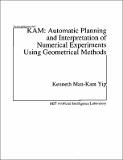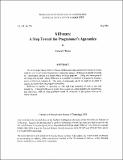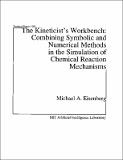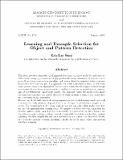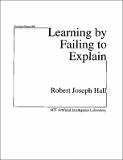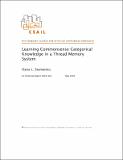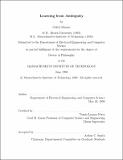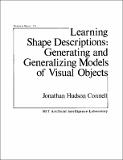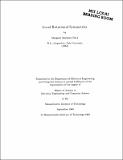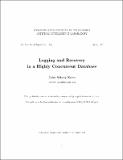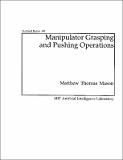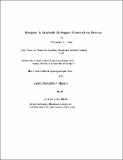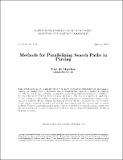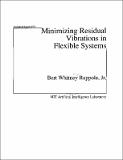Browsing AI Technical Reports (1964 - 2004) by Title
Now showing items 140-159 of 327
-
KAM: Automatic Planning and Interpretation of Numerical Experiments Using Geometrical Methods
(1989-08-01)KAM is a computer program that can automatically plan, monitor, and interpret numerical experiments with Hamiltonian systems with two degrees of freedom. The program has recently helped solve an open problem in ... -
KBEmacs: A Step Toward the Programmer's Apprentice
(1985-05-01)The Knowledge-Based Editor in Emacs (KBEmacs) is the current demonstration system implemented as part of the Programmer's Apprentice project. KBEmacs is capable of acting as a semi-expert assistant to a person who is ... -
The Kineticist's Workbench: Combining Symbolic and Numerical Methods in the Simulation of Chemical Reaction Mechanisms
(1991-05-01)The Kineticist's Workbench is a program that simulates chemical reaction mechanisms by predicting, generating, and interpreting numerical data. Prior to simulation, it analyzes a given mechanism to predict that ... -
Learning and Example Selection for Object and Pattern Detection
(1996-03-13)This thesis presents a learning based approach for detecting classes of objects and patterns with variable image appearance but highly predictable image boundaries. It consists of two parts. In part one, we introduce our ... -
Learning by Failing to Explain
(1986-05-01)Explanation-based Generalization requires that the learner obtain an explanation of why a precedent exemplifies a concept. It is, therefore, useless if the system fails to find this explanation. However, it is not ... -
Learning Commonsense Categorical Knowledge in a Thread Memory System
(2004-05-18)If we are to understand how we can build machines capable of broad purpose learning and reasoning, we must first aim to build systems that can represent, acquire, and reason about the kinds of commonsense knowledge that ... -
Learning from Ambiguity
(1998-12-01)There are many learning problems for which the examples given by the teacher are ambiguously labeled. In this thesis, we will examine one framework of learning from ambiguous examples known as Multiple-Instance learning. ... -
Learning Shape Descriptions: Generating and Generalizing Models of Visual Objects
(1985-09-01)We present the results of an implemented system for learning structural prototypes from grey-scale images. We show how to divide an object into subparts and how to encode the properties of these subparts and the relations ... -
Learning Structural Descriptions from Examples
(1970-09-01)The research here described centers on how a machine can recognize concepts and learn concepts to be recognized. Explanations are found in computer programs that build and manipulate abstract descriptions of scenes ... -
Learning World Models in Environments with Manifest Causal Structure
(1995-05-05)This thesis examines the problem of an autonomous agent learning a causal world model of its environment. Previous approaches to learning causal world models have concentrated on environments that are too "easy" ... -
A Lifetime-based Garbage Collector for LISP Systems on General-Purpose Computers
(1988-02-01)Garbage collector performance in LISP systems on custom hardware has been substantially improved by the adoption of lifetime-based garbage collection techniques. To date, however, successful lifetime-based garbage ... -
Local Rotational Symmetries
(1985-08-01)This thesis describes a new representation for two-dimensional round regions called Local Rotational Symmetries. Local Rotational Symmetries are intended as a companion to Brady's Smoothed Local Symmetry Representation ... -
Logging and Recovery in a Highly Concurrent Database
(1994-06-01)This report addresses the problem of fault tolerance to system failures for database systems that are to run on highly concurrent computers. It assumes that, in general, an application may have a wide distribution in ... -
Manipulator Grasping and Pushing Operations
(1982-06-01)The primary goal of this research is to develop theoretical tools for analysis, synthesis, application of primitive manipulator operations. The primary method is to extend and apply traditional tools of classical mechanics. ... -
MARVEL: A System for Recognizing World Locations with Stereo Vision
(1990-06-01)To use a world model, a mobile robot must be able to determine its own position in the world. To support truly autonomous navigation, I present MARVEL, a system that builds and maintains its own models of world locations ... -
Maximum Entropy Discrimination
(1999-12-01)We present a general framework for discriminative estimation based on the maximum entropy principle and its extensions. All calculations involve distributions over structures and/or parameters rather than specific ... -
Maygen: A Symbolic Debugger Generation System
(1993-05-01)With the development of high-level languages for new computer architectures comes the need for appropriate debugging tools as well. One method for meeting this need would be to develop, from scratch, a symbolic debugger ... -
Methods for Parallelizing Search Paths in Phrasing
(1994-01-01)Many search problems are commonly solved with combinatoric algorithms that unnecessarily duplicate and serialize work at considerable computational expense. There are techniques available that can eliminate redundant ... -
Mid-Level Vision and Recognition of Non-Rigid Objects
(1995-04-01)We address mid-level vision for the recognition of non-rigid objects. We align model and image using frame curves - which are object or "figure/ground" skeletons. Frame curves are computed, without discontinuities, ... -
Minimizing Residual Vibrations in Flexible Systems
(1992-06-01)Residual vibrations degrade the performance of many systems. Due to the lightweight and flexible nature of space structures, controlling residual vibrations is especially difficult. Also, systems such as the Space ...

